Evaluating Risks and Decisions: Risk Management Approaches Report
VerifiedAdded on 2021/01/22
|15
|3230
|130
Report
AI Summary
This report delves into the critical importance of adopting robust risk management approaches to mitigate business risks. It begins by highlighting the significance of the ISO 31000 risk management framework, encompassing various strategies, processes, and principles. The report explores the principles of risk management, emphasizing risk assessment and its role in identifying and responding to threats. It then examines the Enterprise Risk Management (ERM) model as a strategic tool, discussing its implementation and benefits, including its impact on financial reporting and stakeholder confidence. Furthermore, the report analyzes the influence of corporate governance, information technology, and organizational resilience in risk management, highlighting their roles in safeguarding stakeholder rights, leveraging technology for risk visualization and data analysis, and building organizational resilience against disruptions. The report provides a comprehensive overview of risk management, offering valuable insights into the integration of theoretical models and practical applications in strategic and complex situations.
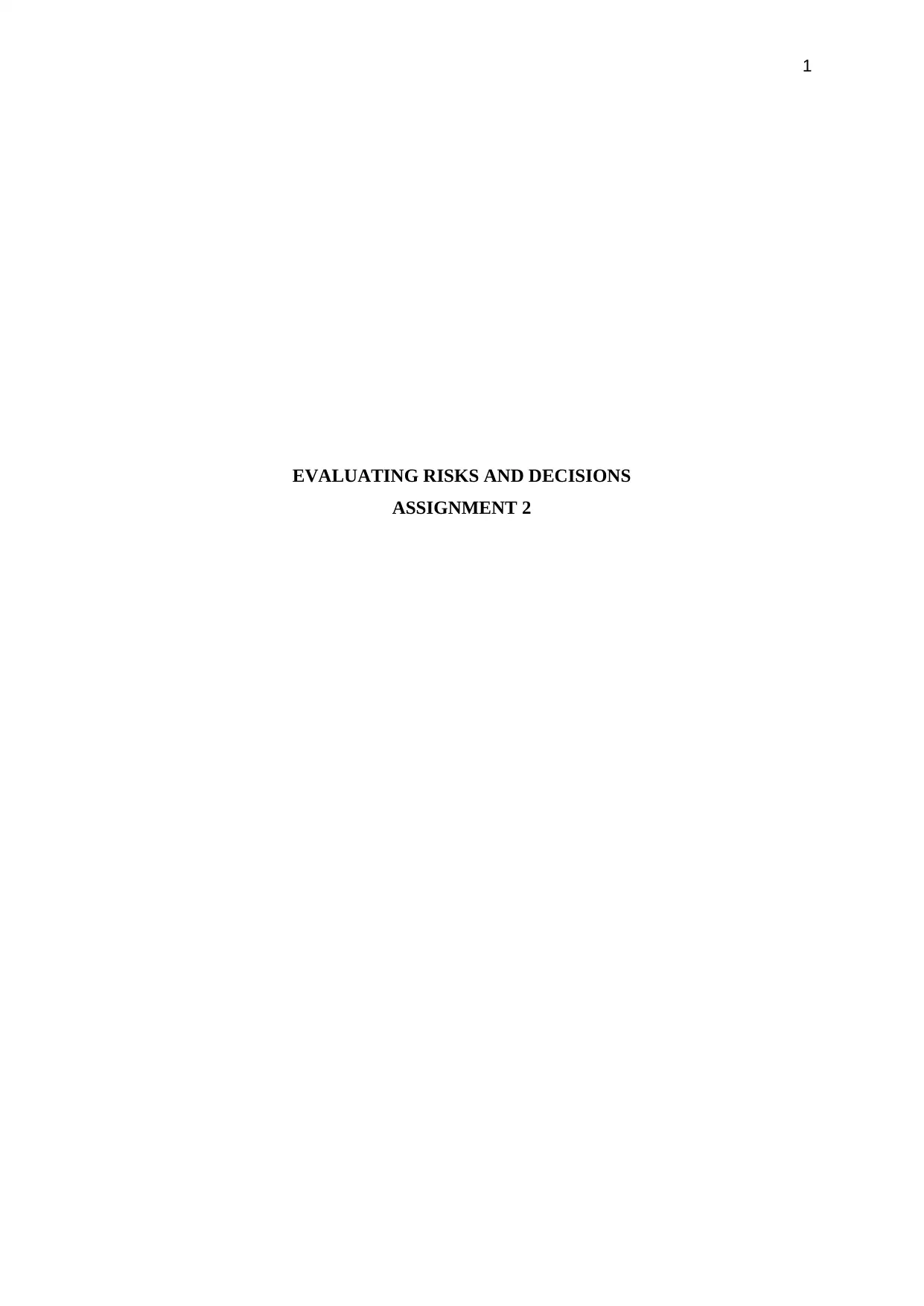
1
EVALUATING RISKS AND DECISIONS
ASSIGNMENT 2
EVALUATING RISKS AND DECISIONS
ASSIGNMENT 2
Paraphrase This Document
Need a fresh take? Get an instant paraphrase of this document with our AI Paraphraser
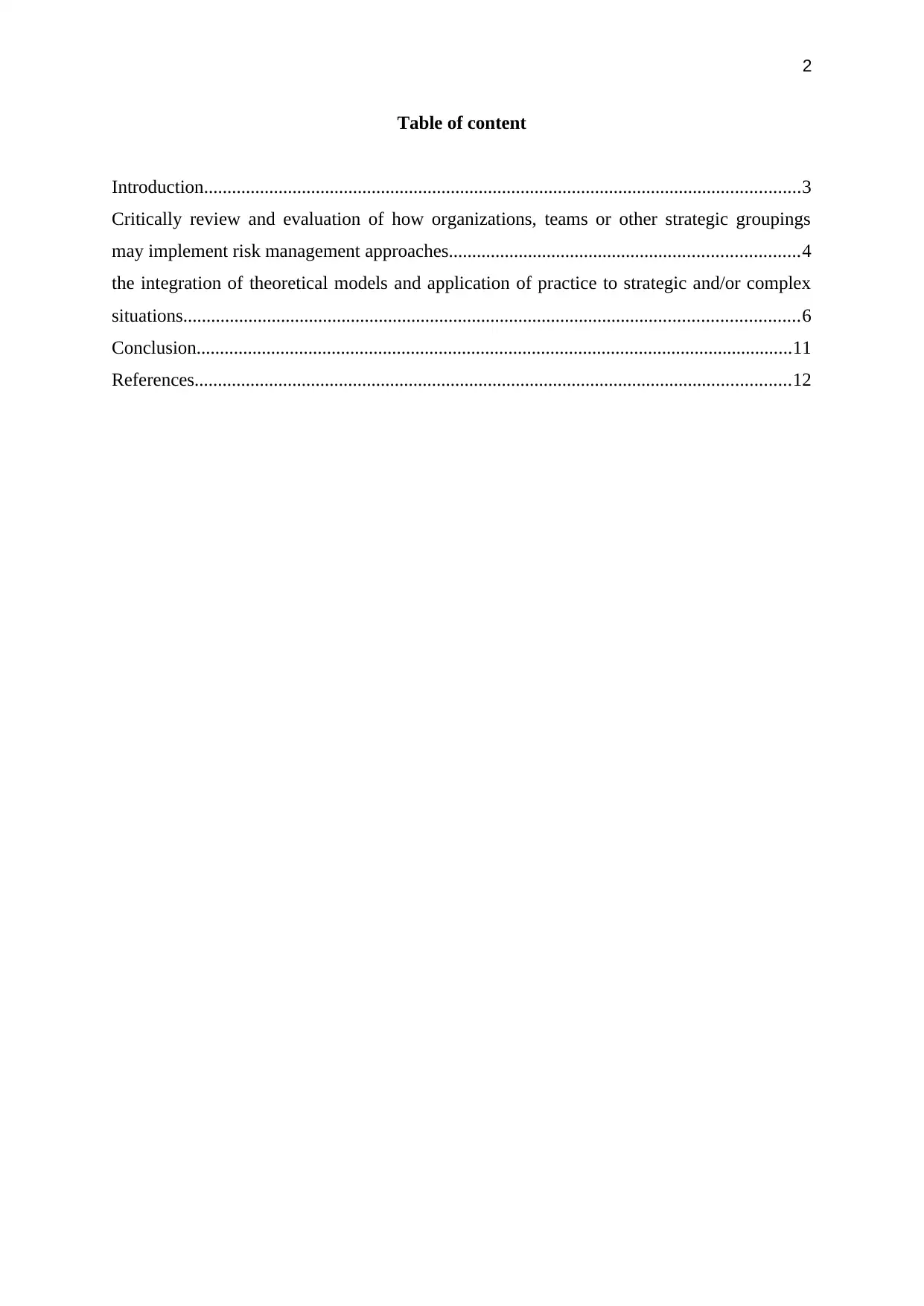
2
Table of content
Introduction................................................................................................................................3
Critically review and evaluation of how organizations, teams or other strategic groupings
may implement risk management approaches...........................................................................4
the integration of theoretical models and application of practice to strategic and/or complex
situations....................................................................................................................................6
Conclusion................................................................................................................................11
References................................................................................................................................12
Table of content
Introduction................................................................................................................................3
Critically review and evaluation of how organizations, teams or other strategic groupings
may implement risk management approaches...........................................................................4
the integration of theoretical models and application of practice to strategic and/or complex
situations....................................................................................................................................6
Conclusion................................................................................................................................11
References................................................................................................................................12
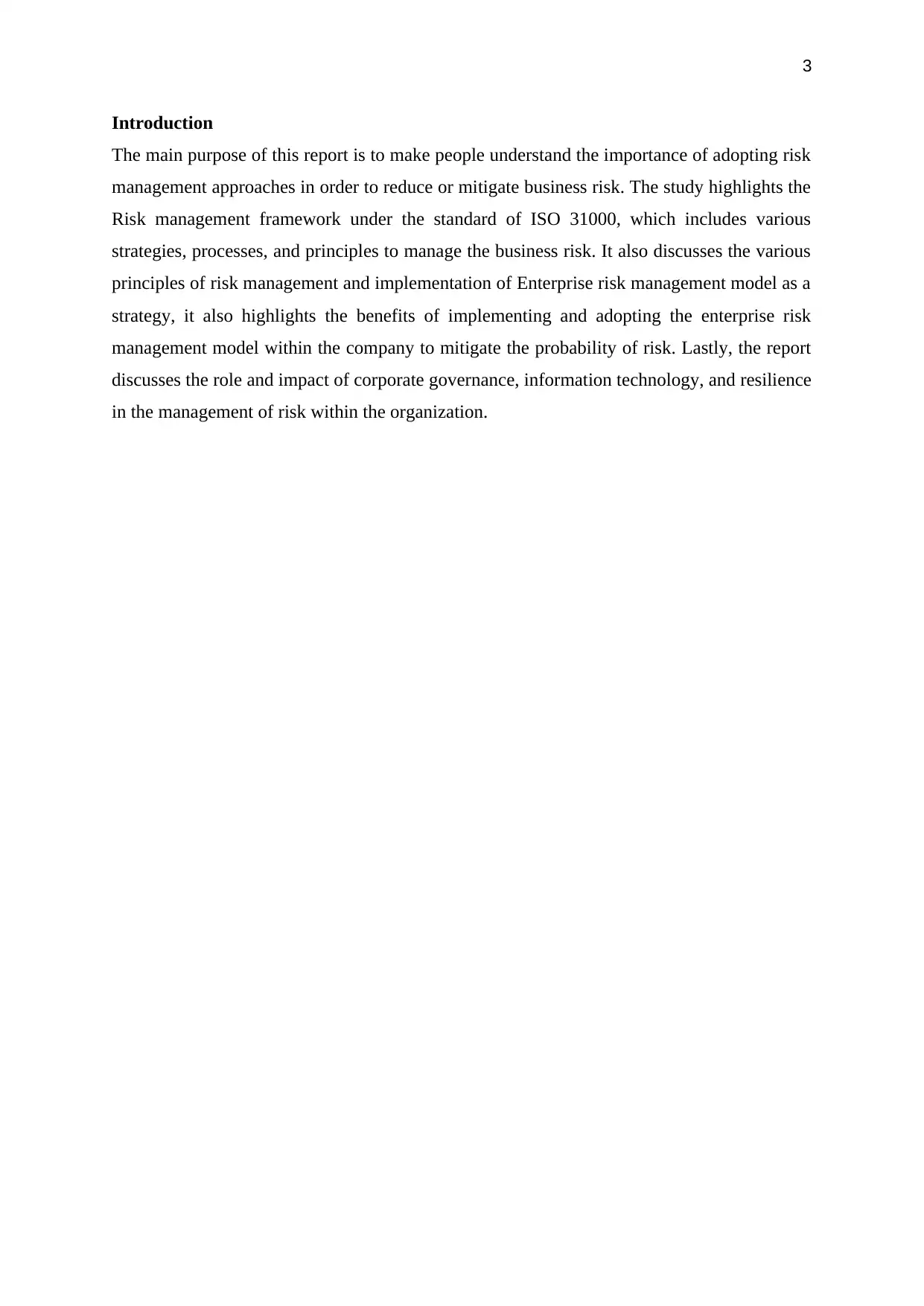
3
Introduction
The main purpose of this report is to make people understand the importance of adopting risk
management approaches in order to reduce or mitigate business risk. The study highlights the
Risk management framework under the standard of ISO 31000, which includes various
strategies, processes, and principles to manage the business risk. It also discusses the various
principles of risk management and implementation of Enterprise risk management model as a
strategy, it also highlights the benefits of implementing and adopting the enterprise risk
management model within the company to mitigate the probability of risk. Lastly, the report
discusses the role and impact of corporate governance, information technology, and resilience
in the management of risk within the organization.
Introduction
The main purpose of this report is to make people understand the importance of adopting risk
management approaches in order to reduce or mitigate business risk. The study highlights the
Risk management framework under the standard of ISO 31000, which includes various
strategies, processes, and principles to manage the business risk. It also discusses the various
principles of risk management and implementation of Enterprise risk management model as a
strategy, it also highlights the benefits of implementing and adopting the enterprise risk
management model within the company to mitigate the probability of risk. Lastly, the report
discusses the role and impact of corporate governance, information technology, and resilience
in the management of risk within the organization.
⊘ This is a preview!⊘
Do you want full access?
Subscribe today to unlock all pages.

Trusted by 1+ million students worldwide
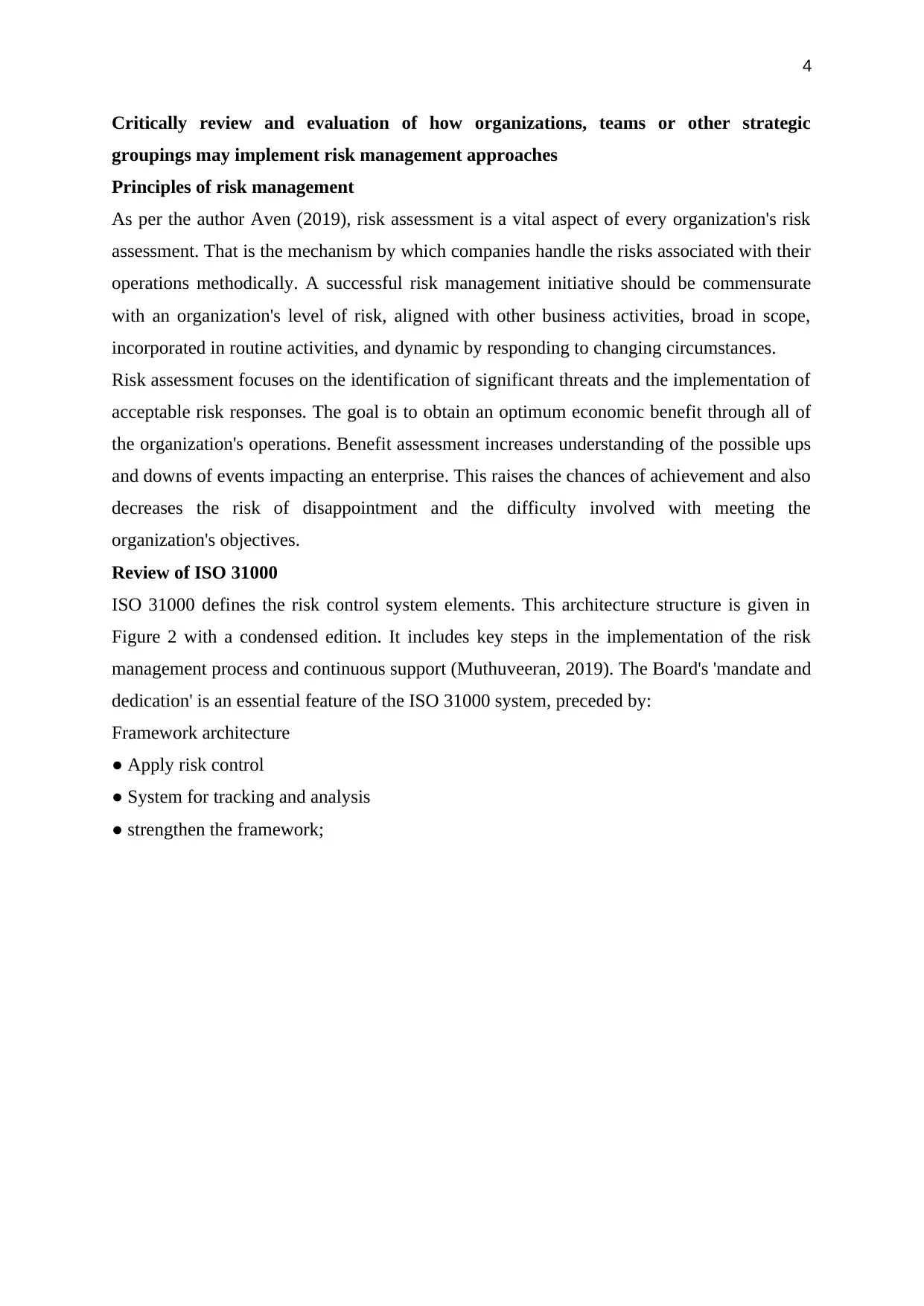
4
Critically review and evaluation of how organizations, teams or other strategic
groupings may implement risk management approaches
Principles of risk management
As per the author Aven (2019), risk assessment is a vital aspect of every organization's risk
assessment. That is the mechanism by which companies handle the risks associated with their
operations methodically. A successful risk management initiative should be commensurate
with an organization's level of risk, aligned with other business activities, broad in scope,
incorporated in routine activities, and dynamic by responding to changing circumstances.
Risk assessment focuses on the identification of significant threats and the implementation of
acceptable risk responses. The goal is to obtain an optimum economic benefit through all of
the organization's operations. Benefit assessment increases understanding of the possible ups
and downs of events impacting an enterprise. This raises the chances of achievement and also
decreases the risk of disappointment and the difficulty involved with meeting the
organization's objectives.
Review of ISO 31000
ISO 31000 defines the risk control system elements. This architecture structure is given in
Figure 2 with a condensed edition. It includes key steps in the implementation of the risk
management process and continuous support (Muthuveeran, 2019). The Board's 'mandate and
dedication' is an essential feature of the ISO 31000 system, preceded by:
Framework architecture
● Apply risk control
● System for tracking and analysis
● strengthen the framework;
Critically review and evaluation of how organizations, teams or other strategic
groupings may implement risk management approaches
Principles of risk management
As per the author Aven (2019), risk assessment is a vital aspect of every organization's risk
assessment. That is the mechanism by which companies handle the risks associated with their
operations methodically. A successful risk management initiative should be commensurate
with an organization's level of risk, aligned with other business activities, broad in scope,
incorporated in routine activities, and dynamic by responding to changing circumstances.
Risk assessment focuses on the identification of significant threats and the implementation of
acceptable risk responses. The goal is to obtain an optimum economic benefit through all of
the organization's operations. Benefit assessment increases understanding of the possible ups
and downs of events impacting an enterprise. This raises the chances of achievement and also
decreases the risk of disappointment and the difficulty involved with meeting the
organization's objectives.
Review of ISO 31000
ISO 31000 defines the risk control system elements. This architecture structure is given in
Figure 2 with a condensed edition. It includes key steps in the implementation of the risk
management process and continuous support (Muthuveeran, 2019). The Board's 'mandate and
dedication' is an essential feature of the ISO 31000 system, preceded by:
Framework architecture
● Apply risk control
● System for tracking and analysis
● strengthen the framework;
Paraphrase This Document
Need a fresh take? Get an instant paraphrase of this document with our AI Paraphraser
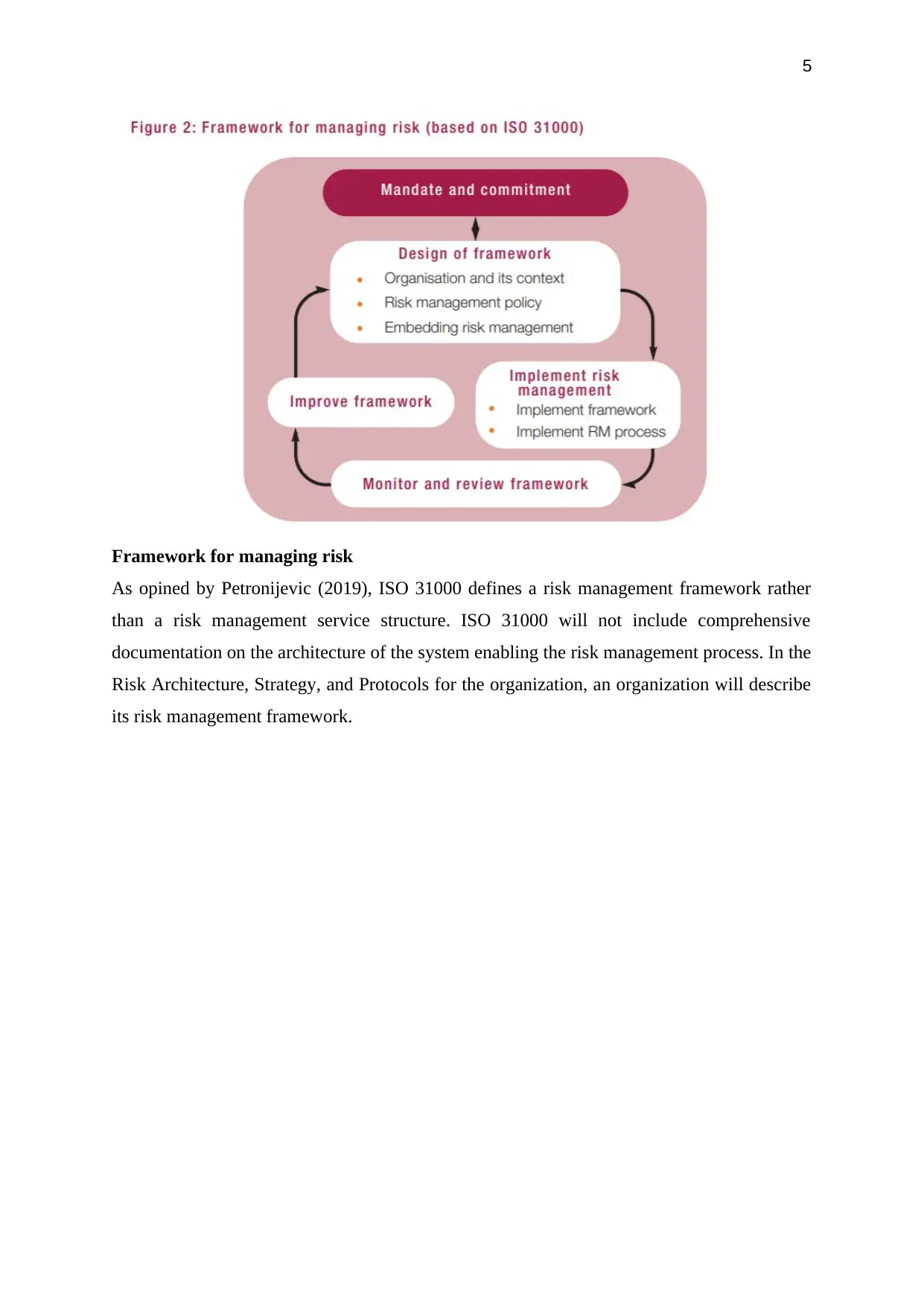
5
Framework for managing risk
As opined by Petronijevic (2019), ISO 31000 defines a risk management framework rather
than a risk management service structure. ISO 31000 will not include comprehensive
documentation on the architecture of the system enabling the risk management process. In the
Risk Architecture, Strategy, and Protocols for the organization, an organization will describe
its risk management framework.
Framework for managing risk
As opined by Petronijevic (2019), ISO 31000 defines a risk management framework rather
than a risk management service structure. ISO 31000 will not include comprehensive
documentation on the architecture of the system enabling the risk management process. In the
Risk Architecture, Strategy, and Protocols for the organization, an organization will describe
its risk management framework.
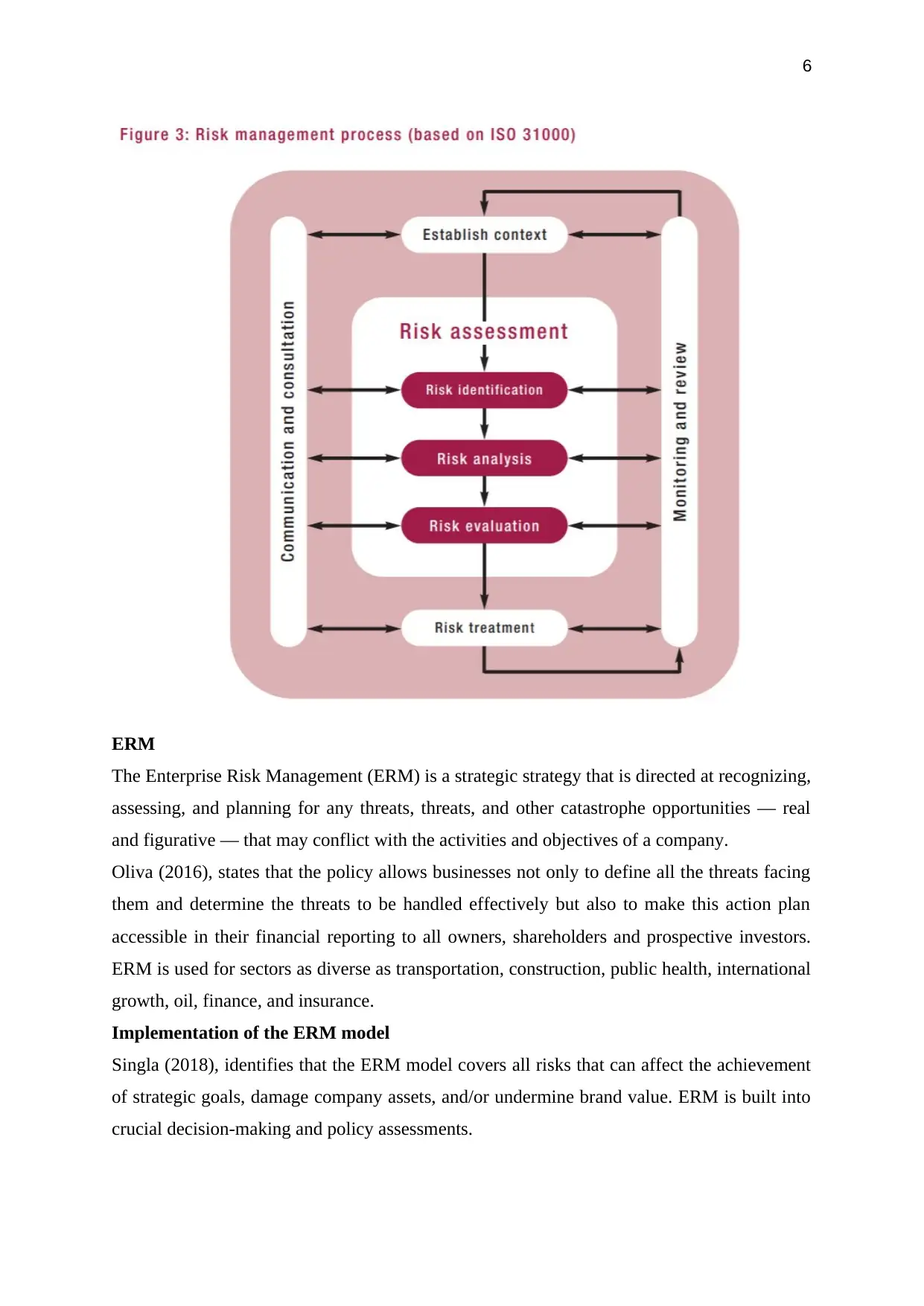
6
ERM
The Enterprise Risk Management (ERM) is a strategic strategy that is directed at recognizing,
assessing, and planning for any threats, threats, and other catastrophe opportunities — real
and figurative — that may conflict with the activities and objectives of a company.
Oliva (2016), states that the policy allows businesses not only to define all the threats facing
them and determine the threats to be handled effectively but also to make this action plan
accessible in their financial reporting to all owners, shareholders and prospective investors.
ERM is used for sectors as diverse as transportation, construction, public health, international
growth, oil, finance, and insurance.
Implementation of the ERM model
Singla (2018), identifies that the ERM model covers all risks that can affect the achievement
of strategic goals, damage company assets, and/or undermine brand value. ERM is built into
crucial decision-making and policy assessments.
ERM
The Enterprise Risk Management (ERM) is a strategic strategy that is directed at recognizing,
assessing, and planning for any threats, threats, and other catastrophe opportunities — real
and figurative — that may conflict with the activities and objectives of a company.
Oliva (2016), states that the policy allows businesses not only to define all the threats facing
them and determine the threats to be handled effectively but also to make this action plan
accessible in their financial reporting to all owners, shareholders and prospective investors.
ERM is used for sectors as diverse as transportation, construction, public health, international
growth, oil, finance, and insurance.
Implementation of the ERM model
Singla (2018), identifies that the ERM model covers all risks that can affect the achievement
of strategic goals, damage company assets, and/or undermine brand value. ERM is built into
crucial decision-making and policy assessments.
⊘ This is a preview!⊘
Do you want full access?
Subscribe today to unlock all pages.

Trusted by 1+ million students worldwide
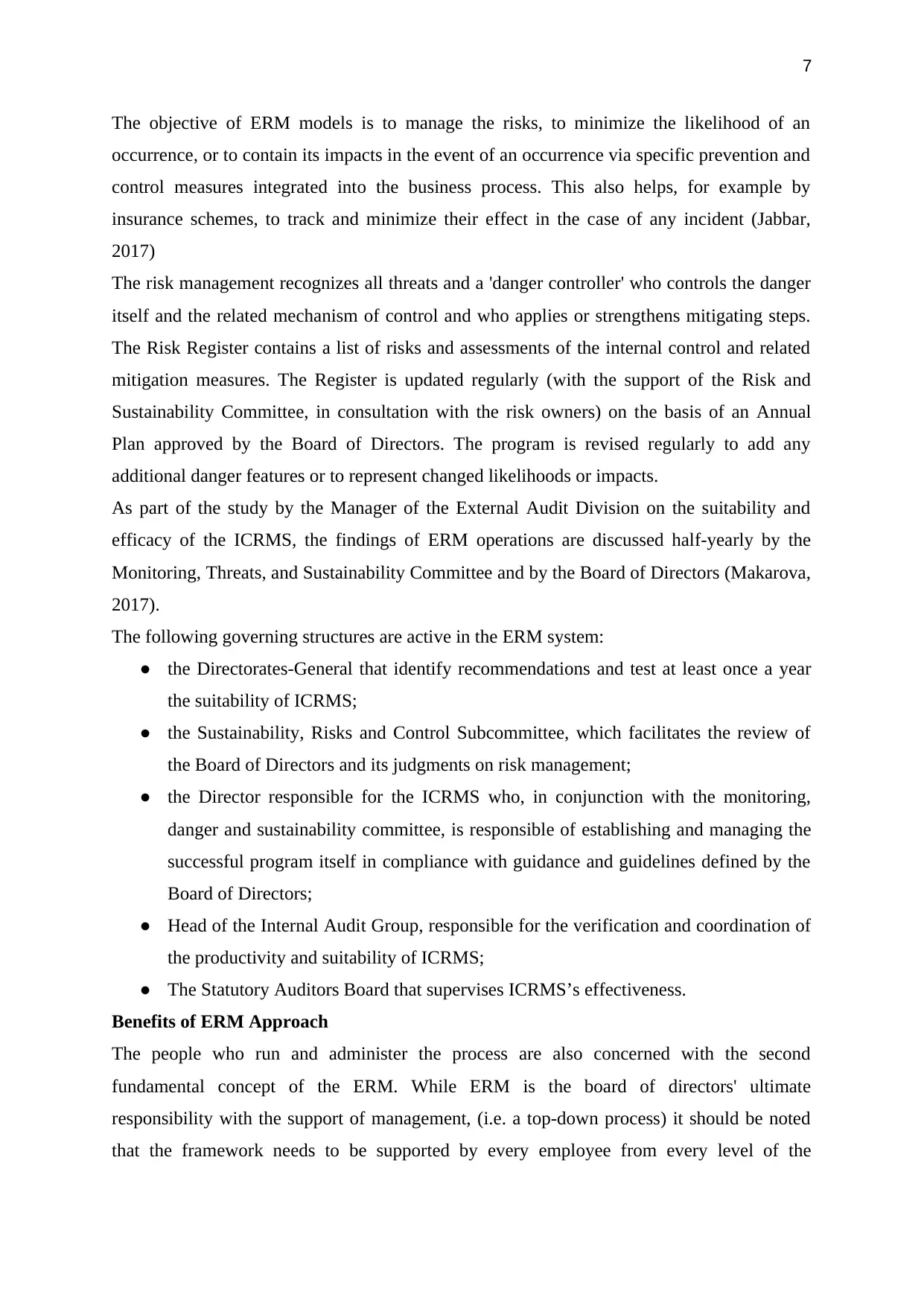
7
The objective of ERM models is to manage the risks, to minimize the likelihood of an
occurrence, or to contain its impacts in the event of an occurrence via specific prevention and
control measures integrated into the business process. This also helps, for example by
insurance schemes, to track and minimize their effect in the case of any incident (Jabbar,
2017)
The risk management recognizes all threats and a 'danger controller' who controls the danger
itself and the related mechanism of control and who applies or strengthens mitigating steps.
The Risk Register contains a list of risks and assessments of the internal control and related
mitigation measures. The Register is updated regularly (with the support of the Risk and
Sustainability Committee, in consultation with the risk owners) on the basis of an Annual
Plan approved by the Board of Directors. The program is revised regularly to add any
additional danger features or to represent changed likelihoods or impacts.
As part of the study by the Manager of the External Audit Division on the suitability and
efficacy of the ICRMS, the findings of ERM operations are discussed half-yearly by the
Monitoring, Threats, and Sustainability Committee and by the Board of Directors (Makarova,
2017).
The following governing structures are active in the ERM system:
● the Directorates-General that identify recommendations and test at least once a year
the suitability of ICRMS;
● the Sustainability, Risks and Control Subcommittee, which facilitates the review of
the Board of Directors and its judgments on risk management;
● the Director responsible for the ICRMS who, in conjunction with the monitoring,
danger and sustainability committee, is responsible of establishing and managing the
successful program itself in compliance with guidance and guidelines defined by the
Board of Directors;
● Head of the Internal Audit Group, responsible for the verification and coordination of
the productivity and suitability of ICRMS;
● The Statutory Auditors Board that supervises ICRMS’s effectiveness.
Benefits of ERM Approach
The people who run and administer the process are also concerned with the second
fundamental concept of the ERM. While ERM is the board of directors' ultimate
responsibility with the support of management, (i.e. a top-down process) it should be noted
that the framework needs to be supported by every employee from every level of the
The objective of ERM models is to manage the risks, to minimize the likelihood of an
occurrence, or to contain its impacts in the event of an occurrence via specific prevention and
control measures integrated into the business process. This also helps, for example by
insurance schemes, to track and minimize their effect in the case of any incident (Jabbar,
2017)
The risk management recognizes all threats and a 'danger controller' who controls the danger
itself and the related mechanism of control and who applies or strengthens mitigating steps.
The Risk Register contains a list of risks and assessments of the internal control and related
mitigation measures. The Register is updated regularly (with the support of the Risk and
Sustainability Committee, in consultation with the risk owners) on the basis of an Annual
Plan approved by the Board of Directors. The program is revised regularly to add any
additional danger features or to represent changed likelihoods or impacts.
As part of the study by the Manager of the External Audit Division on the suitability and
efficacy of the ICRMS, the findings of ERM operations are discussed half-yearly by the
Monitoring, Threats, and Sustainability Committee and by the Board of Directors (Makarova,
2017).
The following governing structures are active in the ERM system:
● the Directorates-General that identify recommendations and test at least once a year
the suitability of ICRMS;
● the Sustainability, Risks and Control Subcommittee, which facilitates the review of
the Board of Directors and its judgments on risk management;
● the Director responsible for the ICRMS who, in conjunction with the monitoring,
danger and sustainability committee, is responsible of establishing and managing the
successful program itself in compliance with guidance and guidelines defined by the
Board of Directors;
● Head of the Internal Audit Group, responsible for the verification and coordination of
the productivity and suitability of ICRMS;
● The Statutory Auditors Board that supervises ICRMS’s effectiveness.
Benefits of ERM Approach
The people who run and administer the process are also concerned with the second
fundamental concept of the ERM. While ERM is the board of directors' ultimate
responsibility with the support of management, (i.e. a top-down process) it should be noted
that the framework needs to be supported by every employee from every level of the
Paraphrase This Document
Need a fresh take? Get an instant paraphrase of this document with our AI Paraphraser
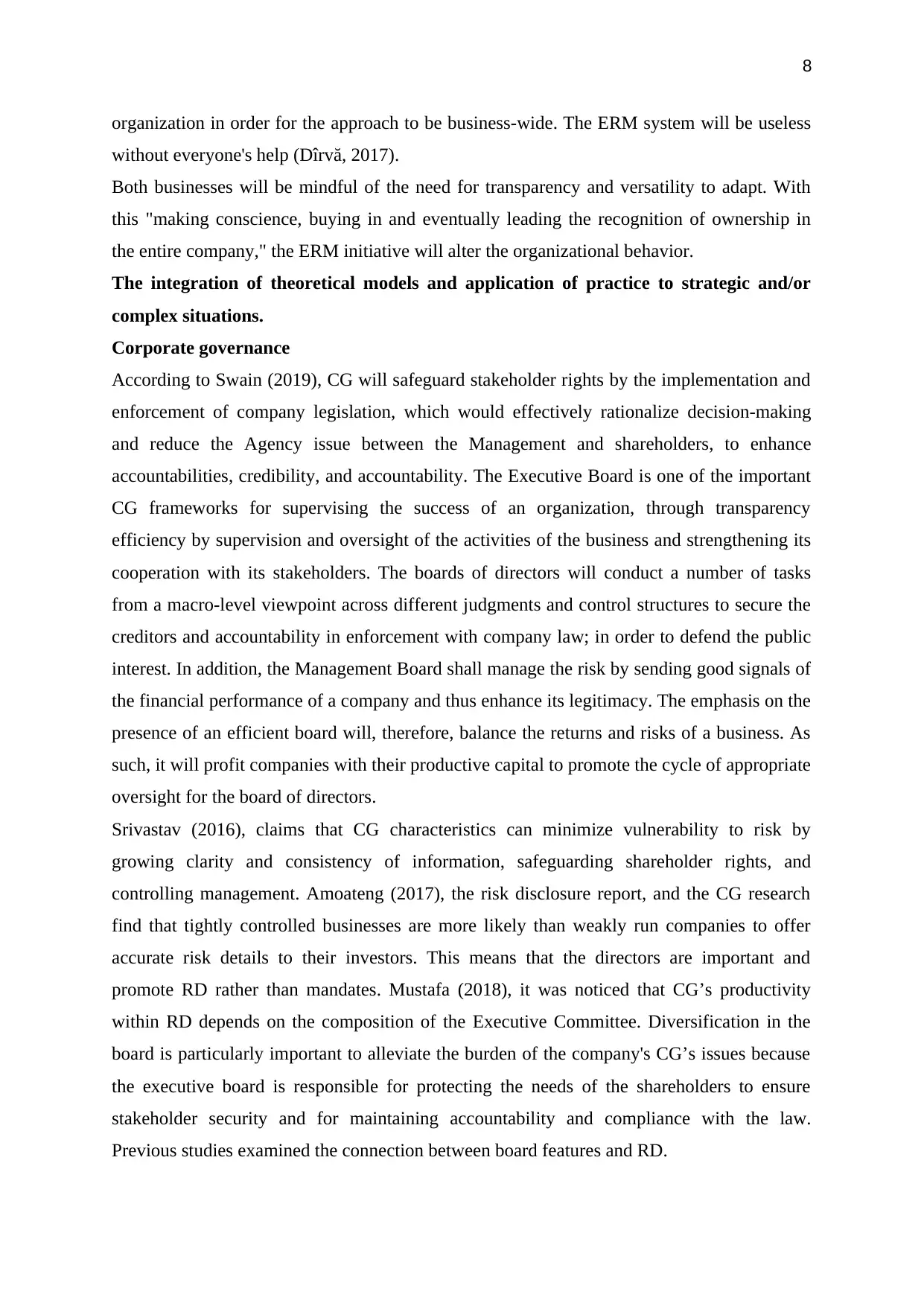
8
organization in order for the approach to be business-wide. The ERM system will be useless
without everyone's help (Dîrvă, 2017).
Both businesses will be mindful of the need for transparency and versatility to adapt. With
this "making conscience, buying in and eventually leading the recognition of ownership in
the entire company," the ERM initiative will alter the organizational behavior.
The integration of theoretical models and application of practice to strategic and/or
complex situations.
Corporate governance
According to Swain (2019), CG will safeguard stakeholder rights by the implementation and
enforcement of company legislation, which would effectively rationalize decision-making
and reduce the Agency issue between the Management and shareholders, to enhance
accountabilities, credibility, and accountability. The Executive Board is one of the important
CG frameworks for supervising the success of an organization, through transparency
efficiency by supervision and oversight of the activities of the business and strengthening its
cooperation with its stakeholders. The boards of directors will conduct a number of tasks
from a macro-level viewpoint across different judgments and control structures to secure the
creditors and accountability in enforcement with company law; in order to defend the public
interest. In addition, the Management Board shall manage the risk by sending good signals of
the financial performance of a company and thus enhance its legitimacy. The emphasis on the
presence of an efficient board will, therefore, balance the returns and risks of a business. As
such, it will profit companies with their productive capital to promote the cycle of appropriate
oversight for the board of directors.
Srivastav (2016), claims that CG characteristics can minimize vulnerability to risk by
growing clarity and consistency of information, safeguarding shareholder rights, and
controlling management. Amoateng (2017), the risk disclosure report, and the CG research
find that tightly controlled businesses are more likely than weakly run companies to offer
accurate risk details to their investors. This means that the directors are important and
promote RD rather than mandates. Mustafa (2018), it was noticed that CG’s productivity
within RD depends on the composition of the Executive Committee. Diversification in the
board is particularly important to alleviate the burden of the company's CG’s issues because
the executive board is responsible for protecting the needs of the shareholders to ensure
stakeholder security and for maintaining accountability and compliance with the law.
Previous studies examined the connection between board features and RD.
organization in order for the approach to be business-wide. The ERM system will be useless
without everyone's help (Dîrvă, 2017).
Both businesses will be mindful of the need for transparency and versatility to adapt. With
this "making conscience, buying in and eventually leading the recognition of ownership in
the entire company," the ERM initiative will alter the organizational behavior.
The integration of theoretical models and application of practice to strategic and/or
complex situations.
Corporate governance
According to Swain (2019), CG will safeguard stakeholder rights by the implementation and
enforcement of company legislation, which would effectively rationalize decision-making
and reduce the Agency issue between the Management and shareholders, to enhance
accountabilities, credibility, and accountability. The Executive Board is one of the important
CG frameworks for supervising the success of an organization, through transparency
efficiency by supervision and oversight of the activities of the business and strengthening its
cooperation with its stakeholders. The boards of directors will conduct a number of tasks
from a macro-level viewpoint across different judgments and control structures to secure the
creditors and accountability in enforcement with company law; in order to defend the public
interest. In addition, the Management Board shall manage the risk by sending good signals of
the financial performance of a company and thus enhance its legitimacy. The emphasis on the
presence of an efficient board will, therefore, balance the returns and risks of a business. As
such, it will profit companies with their productive capital to promote the cycle of appropriate
oversight for the board of directors.
Srivastav (2016), claims that CG characteristics can minimize vulnerability to risk by
growing clarity and consistency of information, safeguarding shareholder rights, and
controlling management. Amoateng (2017), the risk disclosure report, and the CG research
find that tightly controlled businesses are more likely than weakly run companies to offer
accurate risk details to their investors. This means that the directors are important and
promote RD rather than mandates. Mustafa (2018), it was noticed that CG’s productivity
within RD depends on the composition of the Executive Committee. Diversification in the
board is particularly important to alleviate the burden of the company's CG’s issues because
the executive board is responsible for protecting the needs of the shareholders to ensure
stakeholder security and for maintaining accountability and compliance with the law.
Previous studies examined the connection between board features and RD.
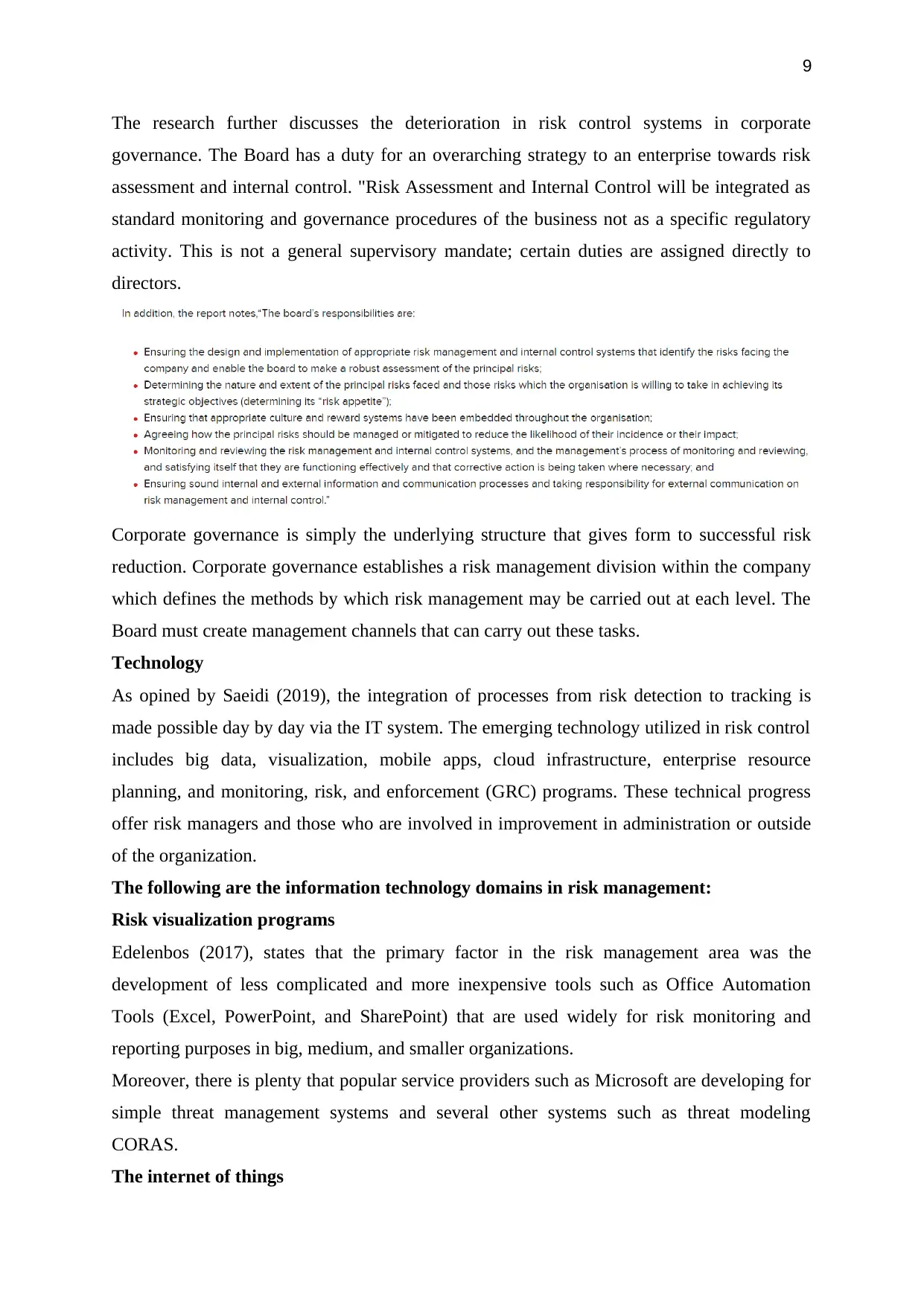
9
The research further discusses the deterioration in risk control systems in corporate
governance. The Board has a duty for an overarching strategy to an enterprise towards risk
assessment and internal control. "Risk Assessment and Internal Control will be integrated as
standard monitoring and governance procedures of the business not as a specific regulatory
activity. This is not a general supervisory mandate; certain duties are assigned directly to
directors.
Corporate governance is simply the underlying structure that gives form to successful risk
reduction. Corporate governance establishes a risk management division within the company
which defines the methods by which risk management may be carried out at each level. The
Board must create management channels that can carry out these tasks.
Technology
As opined by Saeidi (2019), the integration of processes from risk detection to tracking is
made possible day by day via the IT system. The emerging technology utilized in risk control
includes big data, visualization, mobile apps, cloud infrastructure, enterprise resource
planning, and monitoring, risk, and enforcement (GRC) programs. These technical progress
offer risk managers and those who are involved in improvement in administration or outside
of the organization.
The following are the information technology domains in risk management:
Risk visualization programs
Edelenbos (2017), states that the primary factor in the risk management area was the
development of less complicated and more inexpensive tools such as Office Automation
Tools (Excel, PowerPoint, and SharePoint) that are used widely for risk monitoring and
reporting purposes in big, medium, and smaller organizations.
Moreover, there is plenty that popular service providers such as Microsoft are developing for
simple threat management systems and several other systems such as threat modeling
CORAS.
The internet of things
The research further discusses the deterioration in risk control systems in corporate
governance. The Board has a duty for an overarching strategy to an enterprise towards risk
assessment and internal control. "Risk Assessment and Internal Control will be integrated as
standard monitoring and governance procedures of the business not as a specific regulatory
activity. This is not a general supervisory mandate; certain duties are assigned directly to
directors.
Corporate governance is simply the underlying structure that gives form to successful risk
reduction. Corporate governance establishes a risk management division within the company
which defines the methods by which risk management may be carried out at each level. The
Board must create management channels that can carry out these tasks.
Technology
As opined by Saeidi (2019), the integration of processes from risk detection to tracking is
made possible day by day via the IT system. The emerging technology utilized in risk control
includes big data, visualization, mobile apps, cloud infrastructure, enterprise resource
planning, and monitoring, risk, and enforcement (GRC) programs. These technical progress
offer risk managers and those who are involved in improvement in administration or outside
of the organization.
The following are the information technology domains in risk management:
Risk visualization programs
Edelenbos (2017), states that the primary factor in the risk management area was the
development of less complicated and more inexpensive tools such as Office Automation
Tools (Excel, PowerPoint, and SharePoint) that are used widely for risk monitoring and
reporting purposes in big, medium, and smaller organizations.
Moreover, there is plenty that popular service providers such as Microsoft are developing for
simple threat management systems and several other systems such as threat modeling
CORAS.
The internet of things
⊘ This is a preview!⊘
Do you want full access?
Subscribe today to unlock all pages.

Trusted by 1+ million students worldwide
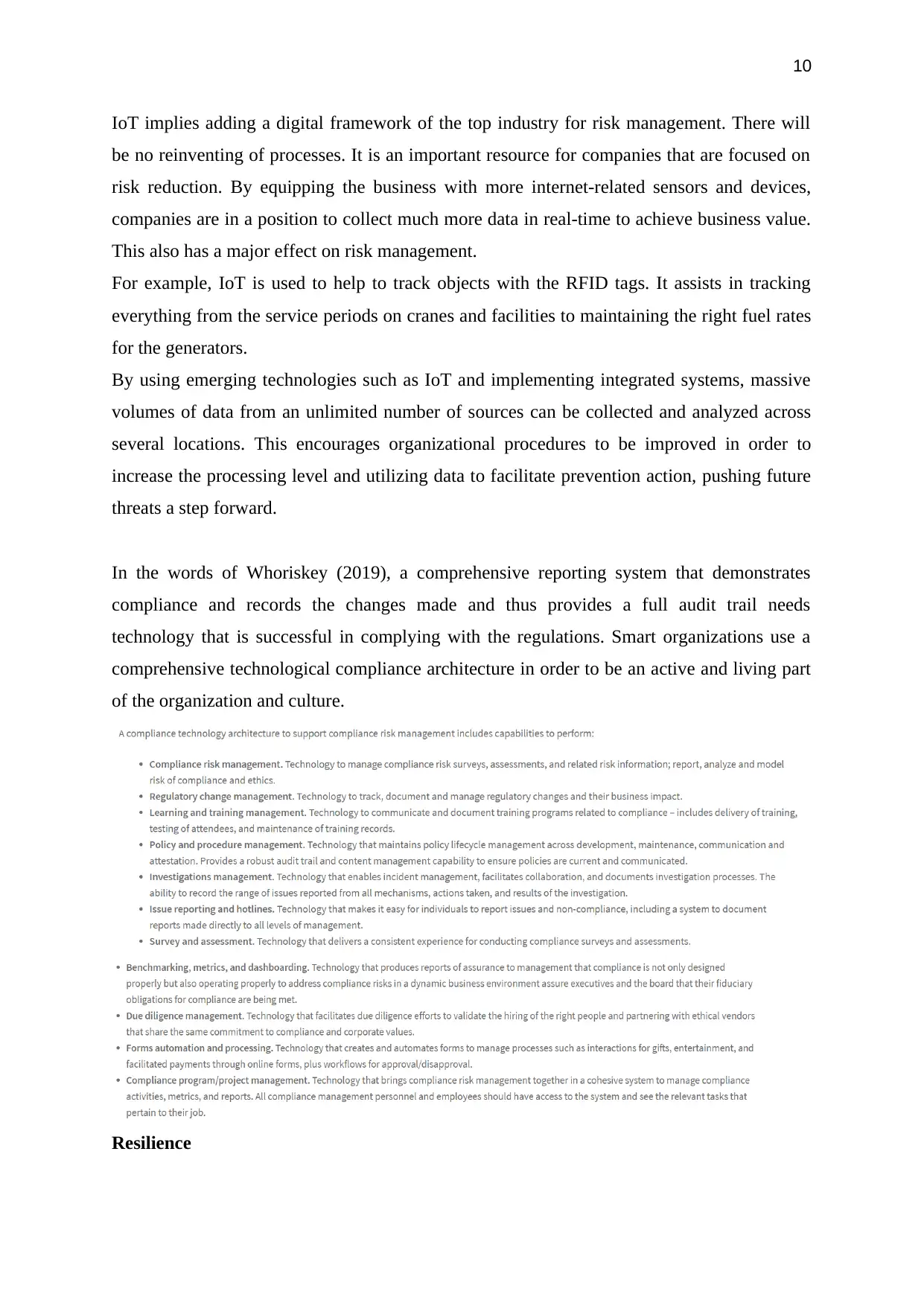
10
IoT implies adding a digital framework of the top industry for risk management. There will
be no reinventing of processes. It is an important resource for companies that are focused on
risk reduction. By equipping the business with more internet-related sensors and devices,
companies are in a position to collect much more data in real-time to achieve business value.
This also has a major effect on risk management.
For example, IoT is used to help to track objects with the RFID tags. It assists in tracking
everything from the service periods on cranes and facilities to maintaining the right fuel rates
for the generators.
By using emerging technologies such as IoT and implementing integrated systems, massive
volumes of data from an unlimited number of sources can be collected and analyzed across
several locations. This encourages organizational procedures to be improved in order to
increase the processing level and utilizing data to facilitate prevention action, pushing future
threats a step forward.
In the words of Whoriskey (2019), a comprehensive reporting system that demonstrates
compliance and records the changes made and thus provides a full audit trail needs
technology that is successful in complying with the regulations. Smart organizations use a
comprehensive technological compliance architecture in order to be an active and living part
of the organization and culture.
Resilience
IoT implies adding a digital framework of the top industry for risk management. There will
be no reinventing of processes. It is an important resource for companies that are focused on
risk reduction. By equipping the business with more internet-related sensors and devices,
companies are in a position to collect much more data in real-time to achieve business value.
This also has a major effect on risk management.
For example, IoT is used to help to track objects with the RFID tags. It assists in tracking
everything from the service periods on cranes and facilities to maintaining the right fuel rates
for the generators.
By using emerging technologies such as IoT and implementing integrated systems, massive
volumes of data from an unlimited number of sources can be collected and analyzed across
several locations. This encourages organizational procedures to be improved in order to
increase the processing level and utilizing data to facilitate prevention action, pushing future
threats a step forward.
In the words of Whoriskey (2019), a comprehensive reporting system that demonstrates
compliance and records the changes made and thus provides a full audit trail needs
technology that is successful in complying with the regulations. Smart organizations use a
comprehensive technological compliance architecture in order to be an active and living part
of the organization and culture.
Resilience
Paraphrase This Document
Need a fresh take? Get an instant paraphrase of this document with our AI Paraphraser
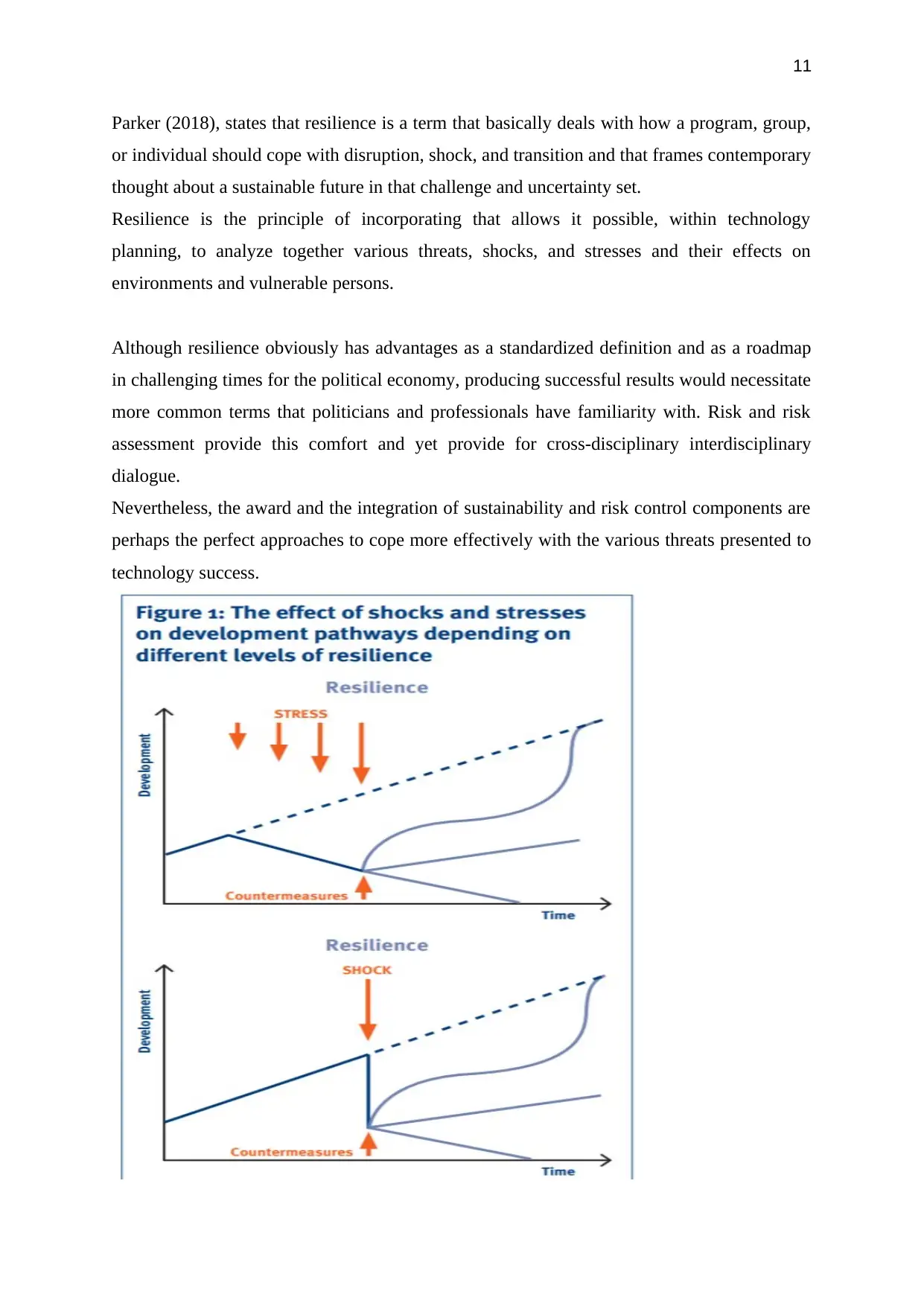
11
Parker (2018), states that resilience is a term that basically deals with how a program, group,
or individual should cope with disruption, shock, and transition and that frames contemporary
thought about a sustainable future in that challenge and uncertainty set.
Resilience is the principle of incorporating that allows it possible, within technology
planning, to analyze together various threats, shocks, and stresses and their effects on
environments and vulnerable persons.
Although resilience obviously has advantages as a standardized definition and as a roadmap
in challenging times for the political economy, producing successful results would necessitate
more common terms that politicians and professionals have familiarity with. Risk and risk
assessment provide this comfort and yet provide for cross-disciplinary interdisciplinary
dialogue.
Nevertheless, the award and the integration of sustainability and risk control components are
perhaps the perfect approaches to cope more effectively with the various threats presented to
technology success.
Parker (2018), states that resilience is a term that basically deals with how a program, group,
or individual should cope with disruption, shock, and transition and that frames contemporary
thought about a sustainable future in that challenge and uncertainty set.
Resilience is the principle of incorporating that allows it possible, within technology
planning, to analyze together various threats, shocks, and stresses and their effects on
environments and vulnerable persons.
Although resilience obviously has advantages as a standardized definition and as a roadmap
in challenging times for the political economy, producing successful results would necessitate
more common terms that politicians and professionals have familiarity with. Risk and risk
assessment provide this comfort and yet provide for cross-disciplinary interdisciplinary
dialogue.
Nevertheless, the award and the integration of sustainability and risk control components are
perhaps the perfect approaches to cope more effectively with the various threats presented to
technology success.

12
In the words of Aveni (2018), resilience includes, in turn, the capacity of processes to
experience smooth and regulated deterioration, the potential to rebound against loss, the
ability to manage output gaps, the development and creation of traditional mental templates,
versatility on structures and organizations, and a reduction in sophistication and coupling.
The comprehensive structure for Resilience in risk reduction is:
● It has a regional framework for the measurement and engagement of processes from
families and populations to national and sub-national rates.
● emphasize hazard or disturbance management capabilities
● It helps explore ways to tackle confusion, challenges, and improvements
● It is positive
In the words of Aveni (2018), resilience includes, in turn, the capacity of processes to
experience smooth and regulated deterioration, the potential to rebound against loss, the
ability to manage output gaps, the development and creation of traditional mental templates,
versatility on structures and organizations, and a reduction in sophistication and coupling.
The comprehensive structure for Resilience in risk reduction is:
● It has a regional framework for the measurement and engagement of processes from
families and populations to national and sub-national rates.
● emphasize hazard or disturbance management capabilities
● It helps explore ways to tackle confusion, challenges, and improvements
● It is positive
⊘ This is a preview!⊘
Do you want full access?
Subscribe today to unlock all pages.

Trusted by 1+ million students worldwide
1 out of 15
Related Documents
Your All-in-One AI-Powered Toolkit for Academic Success.
+13062052269
info@desklib.com
Available 24*7 on WhatsApp / Email
![[object Object]](/_next/static/media/star-bottom.7253800d.svg)
Unlock your academic potential
Copyright © 2020–2025 A2Z Services. All Rights Reserved. Developed and managed by ZUCOL.





